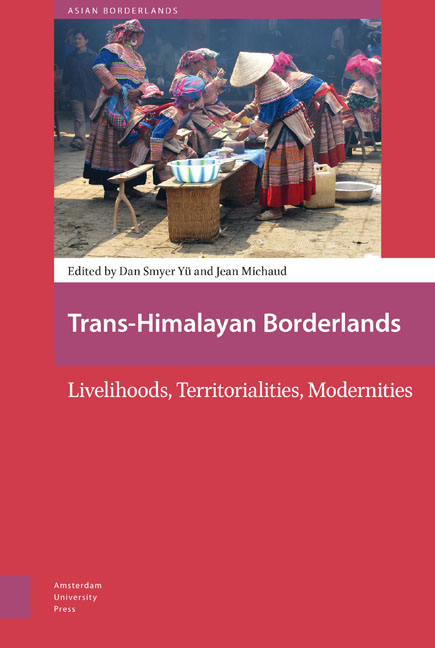Book contents
- Frontmatter
- Contents
- Acknowledgements
- Introduction: Trans-Himalayas as Multistate Margins
- I Territory, Worldviews, and Power Through Time
- 1 Adjusting Livelihood Structure in the Southeast Asian Massif
- 2 The Properties of Territory in Nepal’s State of Transformation
- 3 Trans-Himalayan Buddhist Secularities: Sino-Indian Geopolitics of Territoriality in Indo-Tibetan Interface
- 4 Buddhist Books on Trans-Himalayan Pathways: Materials and Technologies Connecting People and Ecological Environments in a Transnational Landscape
- 5 Seeking China's Back Door: On English Handkerchiefs and Global Local Markets in the Early Nineteenth Century
- II Livelihood Reconstructions, Flows, and Trans-Himalayan Modernities
- 6 Contested Modernities: Place, Subjectivity, and Himalayan Dam Infrastructures
- 7 Plurality and Plasticity of Everyday Humanitarianism in the Karen Conflict
- 8 Being Modern: Livelihood Reconstruction among Land-lost Peasants in Chenggong (Kunming)
- 9 Tibetan Wine Production, Taste of Place, and Regional Niche Identities in Shangri-La, China
- 10 Tea and Merit: Landscape Making in the Ritual Lives of the De’ang People in Western Yunnan
- 11 In-between Poppy and Rubber Fields: Experimenting a Transborder Livelihood among the Akha in the Northwestern Frontier of Laos
- 12 A Fortuitous Frontier Opportunity: Cardamom Livelihoods in the Sino-Vietnamese Borderlands
- Conclusion: Frictions in Trans-Himalayan Studies
- Index
Introduction: Trans-Himalayas as Multistate Margins
Published online by Cambridge University Press: 12 December 2020
- Frontmatter
- Contents
- Acknowledgements
- Introduction: Trans-Himalayas as Multistate Margins
- I Territory, Worldviews, and Power Through Time
- 1 Adjusting Livelihood Structure in the Southeast Asian Massif
- 2 The Properties of Territory in Nepal’s State of Transformation
- 3 Trans-Himalayan Buddhist Secularities: Sino-Indian Geopolitics of Territoriality in Indo-Tibetan Interface
- 4 Buddhist Books on Trans-Himalayan Pathways: Materials and Technologies Connecting People and Ecological Environments in a Transnational Landscape
- 5 Seeking China's Back Door: On English Handkerchiefs and Global Local Markets in the Early Nineteenth Century
- II Livelihood Reconstructions, Flows, and Trans-Himalayan Modernities
- 6 Contested Modernities: Place, Subjectivity, and Himalayan Dam Infrastructures
- 7 Plurality and Plasticity of Everyday Humanitarianism in the Karen Conflict
- 8 Being Modern: Livelihood Reconstruction among Land-lost Peasants in Chenggong (Kunming)
- 9 Tibetan Wine Production, Taste of Place, and Regional Niche Identities in Shangri-La, China
- 10 Tea and Merit: Landscape Making in the Ritual Lives of the De’ang People in Western Yunnan
- 11 In-between Poppy and Rubber Fields: Experimenting a Transborder Livelihood among the Akha in the Northwestern Frontier of Laos
- 12 A Fortuitous Frontier Opportunity: Cardamom Livelihoods in the Sino-Vietnamese Borderlands
- Conclusion: Frictions in Trans-Himalayan Studies
- Index
Summary
Abstract
This introductory chapter lays out a roadmap of the book regarding its overarching themes, conceptual concerns, and individual chapter highlights. It attempts to initiate a trans-Himalayan study aimed at an ethnoculturally and ecologically coherent but geopolitically demarcated world region. Based on the borderland perspectives of the contributors, it deems the trans-Himalayan region a space of multiple state margins between which connectivity and disconnectivity concurrently take place. Concerning the diversity of trans-Himalayan livelihood, territoriality, and modernity, the chapter emphasizes the criticalness of ecological forces, which, along with human-induced global-local forces of change, reshape the multidimensional borderland engagements between different ethnic communities and nation-states in the greater Himalayan region, including the highlands of Southeast Asia and Southwest China.
Keywords: Trans-Himalayas, Zomia, livelihood, horizontal connectivity, multistate margins
The Project
The concept of this book emerged from two conferences held in March 2013: ‘Everyday Religion and Sustainable Environments in the Himalaya’ and ‘Himalayan Connection: Disciplines, Geographies, and Trajectories’ – organized respectively by the India China Institute of the New School and the Yale Himalaya Initiative. Both conferences showcased a wide range of papers addressing historical and current topics from diverse ecosystems, human communities, and nation-states in the Himalayas. The inquiries pertaining to how we have conceived and are reconceiving Himalayan studies culminated in the keynote presentations and discussions of James Scott, Sara Shneiderman, and Charles Ramble. The themes centered on the conceptual interfacing of concepts of Zomia (Van Schendel 2002; Scott 2009; Michaud 2010) and the Himalayas, deconstructing and reconstructing disciplinary boundaries, and the historical and current shifting of borderlands and territories. First coined by Willem van Schendel, ‘Zomia’ is a term etymologically derived from Tibetan-Burmese languages spoken in the Himalayas and is used to refer to contiguous regions in Northeast India, Southeast Asia, Southwest China, and the Tibetan Plateau (Van Schendel 2002). Its subsequent evolutions by James Scott, Jean Michaud, and Sara Shneiderman have different geographical coverages, contributing toward rich theoretical ground.
While the interdisciplinary reconceptualizations of the complexity of bordered connectivity in modern High Asia underlined the core theoretical inquiries of the two conferences, it was also discernible that the default conception of the Himalayas as a region was centered mostly on the geography of the Himalayan territories of Nepal, Tibet, and India, limiting how we explore new frontiers and the diversity of Himalayan studies.
- Type
- Chapter
- Information
- Trans-Himalayan BorderlandsLivelihoods, Territorialities, Modernities, pp. 11 - 42Publisher: Amsterdam University PressPrint publication year: 2017
- 1
- Cited by



